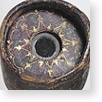
Although the first "spyglasses" were fabricated in Holland in the early 17th century, Galileo alone immediately realized their great astronomical potential. Using two lenses, a plane-convex objective and a plane-concave eyepiece, he perfected the telescope, improving it to a magnifying power of 20 and designing accessories that made it not only an observation instrument but also a device for measuring astronomical phenomena. With his instruments Galileo managed to tabulate the orbital periods of Jupiter's satellites, recording them on an extraordinary analogue computer, the Jovilabe. By using this instrument in combination with a clock featuring an innovative pendulum escapement, Galileo believed he could solve the crucial problem of determining longitude at sea.
Application of the pendulum to the clock
Inv. 2433
Author unknown, 19th cent. (copy)
Dialogo sopra i due massimi sistemi del mondo, Galileo Galilei (facsimile)
Firenze, Museo Galileo, MED 1190
Galileo Galilei, Florence, original 1632 / facsimile 2010
Galileo's objective lens
Inv. 2429
Vittorio Crosten (frame), lens: late 1609 - early 1610 / frame: 1677
Galileo's telescope
Inv. 2428
Galileo Galilei, Italian, late 1609 - early 1610
Galileo's telescope
Inv. 2427
Galileo Galilei, Italian, ca. 1610
Jovilabe
Inv. 3178
Maker unknown, second half 17th cent.
Model of the application of the pendulum to the clock
Inv. 2085
Eustachio Porcellotti, Florence, 1877
Sidereus Nuncius, Galileo Galilei (facsimile)
Firenze, Biblioteca nazionale centrale, Post. 110
Galileo Galilei, Padua, original 1610 / facsimile 2010
















